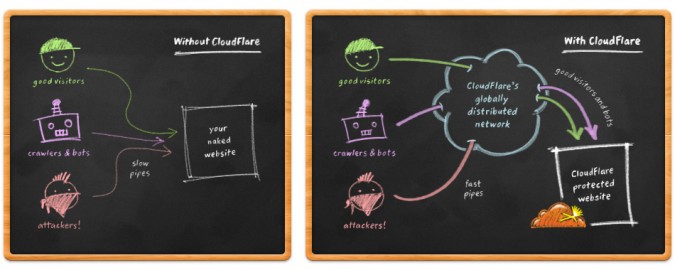CloudFlare – what do you think?
I learned about an interesting company called CloudFlare yesterday, and I wonder what people think about their service. On first look, it seems great. But it also seems almost too good to be true, so I’d thought I’d write about it and see what kind of comments surface.
Here’s a recent article written by the CEO and co-founder of CloudFlare. This appeared on TechCrunch, and the article generated a lot of comments, many of them suspicious that CloudFlare’s business model is unworkable.
Before I describe CloudFlare, here’s how the company describes its service on its overview page:
CloudFlare protects and accelerates any website online. Once your website is a part of the CloudFlare community, its web traffic is routed through our intelligent global network. We automatically optimize the delivery of your web pages so your visitors get the fastest page load times and best performance. We also block threats and limit abusive bots and crawlers from wasting your bandwidth and server resources. The result: CloudFlare-powered websites see a significant improvement in performance and a decrease in spam and other attacks.
CloudFlare’s system gets faster and smarter as our community of users grows larger. We have designed the system to scale with our goal in mind: helping power and protect the entire Internet.
CloudFlare can be used by anyone with a website and their own domain, regardless of your choice in platform. From start to finish, setup takes most website owners less than 5 minutes. Adding your website requires only a simple change your domain’s DNS settings. There is no hardware or software to install or maintain and you do not need to change any of your site’s existing code. If you are ever unhappy you can turn CloudFlare off as easily as you turned it on. Our core service is free and we offer enhanced services for websites who need extra features like real time reporting or SSL.
Here’s my summary on what CloudFlare does:
Let CloudFlare take over your DNS. They will then copy the static parts of your site to their servers in 5 geographically diverse data centers, and when web visitors try to visit your site, CloudFlare will serve the static parts of your site from their mirror copy that is closest to the web visitor. This will make your website load faster, pleasing your visitors. Since all your traffic is seen by CloudFlare, they can also do some security analysis, and block traffic they deem to be unwanted, saving you from having to do this security analysis yourself. CloudFlare provides this service for free to most users, and makes money by charging $20 a month to some sites that want more features.
I asked one of their engineers how they figure out what parts of your site are suitable for mirroring, and he said they watch how Google caches your site and mimick what Google is doing. If this is cool with Google, I’m impressed with this technique, since CloudFlare doesn’t have to develop, maintain and improve code to figure this problem out itself.
The big issue I see is that $20 a month is a tiny amount of money, and if a big site signed up, I worry that site could bleed CloudFlare to death with bandwidth costs, which CloudFlare apparently is paying itself from the $20 a month.
This reminds me of a story I heard years ago about Purple Communications, the company I sold my first Internet startup to to in the first dot com bubble. Purple was then offering unlimited Blackberry airtime for $59.95 a month, but they had to purchase the actual airtime from actual wireless carriers, since they were a value added reseller. This was viable with modest Blackberry users, but sadly, a few customers were using their devices way too much, and were costing Purple thousands of dollars a month per device! They solved this by changing their terms of service and kicking these unprofitable customers to the curb, but it was a tough lesson to learn and respond to.
I hope CloudFlare doesn’t have to relearn much the same lesson.
I briefly met the CloudFlare founders last night, and they all seem quite sharp, so I think there’s a good chance they won’t fall into this trap without a way out. This company is one I will watch, and I wish them the best of success.


